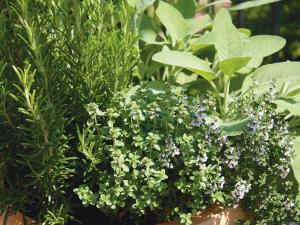Members of mint family are easy to grow and versatile
Soon enough it will be summer, a time for family reunions, with lazy days sipping a mint julep and pondering. Indeed, why a mint julep, as if there are any juleps other than mint? Such an old name, julep. Julep comes to us from Persian “gulab” meaning "rose water." Julep or not, the mint family has some surprising members.
Basil, rosemary, sage, savory, marjoram, oregano, thyme and lavender are all part of the mint extended family. However, there are also decorative members of the mint family such as coleus and chia.
Some members of the mint family have gone to pot. One of the easiest ways to grow any member of the mint family is in a pot. Potted lavender can scent a room or a patio. Potted basil, rosemary and thyme can not only get you humming old Simon and Garfunkel tunes but can literally spice up your cooking. To pot up any mint family member, use any general potting mix. Good drainage is essential so the roots do not rot. Put stones or broken pottery in the bottom of each pot before adding the potting soil. Occasional feed your potted mints with a diluted organic fish emulsion or a compost tea.
If you have room outdoors, of course, you can plant any of the mint family directly in the garden. Choose a damp area for spearmint and peppermint. Plant most of the others in full sun or partial shade. Fertilize with any good organic fertilizer such as compost, fish emulsion and bone meal.
Mulch is a good idea, especially during the heat of summer. Keep the plant roots moist, but not soggy. All of these plants will die back if the soil dries out completely.
To keep any of these plants in bounds, or to harvest the edible leaves, cut the growing tips of the stems. Many of these bloom, though in the case of basil, oregano and thyme you want to discourage flowering, because you harvest the leaves. When these herbs set flowers, the leaves often lose their flavor. We grow other mint family members such as lavender for their flowers, so do not pinch off the growing stems.
You could probably devote an entire garden just to mint plants. And drink it all in with teas, not only peppermint and spearmint tea. Mint tea was a traditional remedy for stomach pain.
Besides cooking and decoration, mints are popular because they are so easily propagated by stem cuttings. Take any member of the mint family and cut a short piece of stem with a few leaves attached. You can dip it in a hormone rooting powder, pot it up, and cover with a plastic tent to retain humidity. Keep it well watered and out of direct light, and you will soon have a new member of the family. Or you can just stick the cutting in water and hope it roots. Being a mint, it probably will.
A nice advantage of rooting a cutting over growing from seeds is that the new plants bear a family resemblance to each other because they are clones, and genetically identical to each other and to the parent plant.
By cloning your best plants, you will soon have bigger, tastier basil leaves, more fragrant lavender blossoms, and more colorful coleus leaves. You can root any of these easily and give plants away. Or sell them. You would probably make a mint.




















































